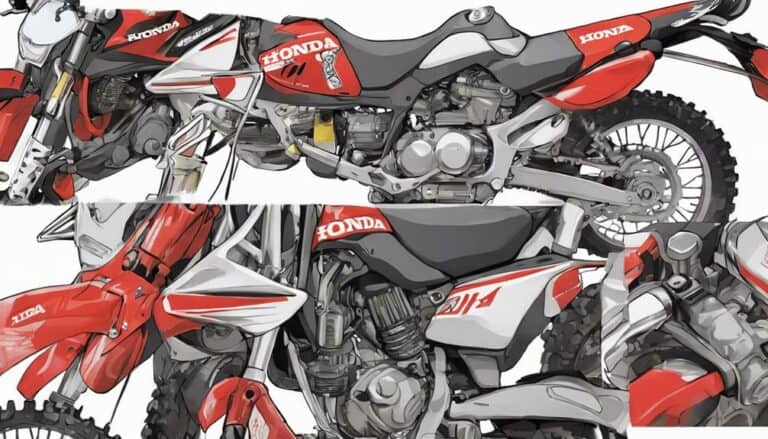If you're feeling daunted by the prospect of fixing your 2013 80cc Honda dirt bike clutch, don't worry, it's a manageable task with the right guidance.
By following a few straightforward steps, you can have your clutch operating smoothly in no time.
From diagnosing common clutch issues to understanding the tools needed for the repair, this discussion will equip you with the knowledge to tackle the job effectively.
Stay tuned to discover the key insights on how to troubleshoot and resolve clutch problems on your Honda dirt bike.
Key Takeaways
- Adjust clutch cable tension for smooth engagement
- Use proper tools like Clutch Holder and Puller
- Regularly inspect and maintain clutch components
- Seek expert advice for persistent clutch issues
Symptoms of Clutch Issues
If you notice your 2013 80cc Honda dirt bike slipping or having trouble engaging gears, these could be signs of clutch issues. When your bike's clutch starts acting up, it's important to diagnose and address the problem promptly.
Unusual noises or vibrations during gear shifts could indicate potential clutch issues that need your attention. Another red flag to watch out for is a spongy or inconsistent clutch lever feel, which might signal air or fluid leaks in the clutch system.
To get your bike back together and running smoothly, make sure to pay attention to any difficulty finding neutral or experiencing dragging when releasing the clutch. These symptoms could point to adjustment or mechanical problems that require immediate intervention.
Tools Needed for Repair
Gather the necessary tools, including wrenches, sockets, pliers, and a screwdriver, to begin the repair of the clutch on your 2013 80cc Honda dirt bike. For a successful clutch fix, consider the following tool recommendations and troubleshooting tips:
| Tools | Recommendations |
|---|---|
| Clutch Holder Tool | Essential for securing the clutch hub in place during nut removal and installation |
| Clutch Puller Tool | Required to safely remove the clutch from the bike without causing damage |
| Impact Driver | Helpful for loosening tight bolts and screws with minimal effort and reducing the risk of stripping |
| Service Manual | Provides detailed instructions on disassembling and reassembling clutch components for DIY repair |
| Safety Gear | Wear gloves and eye protection to prevent injuries from sharp edges or flying debris during the repair |
When tackling the clutch repair, these DIY repair techniques, combined with the right tools, will empower you to efficiently address the issue and get back to enjoying your Honda dirt bike.
Step-by-Step Clutch Adjustment
To adjust the clutch on your 2013 80cc Honda dirt bike, start by loosening the lock nut on the clutch cable adjuster to modify the free play in the clutch lever. Turning the adjuster clockwise increases free play, while turning it counterclockwise decreases it. Aim for about 1/8 to 1/4 inch of free play at the clutch lever for smooth engagement.
After adjusting, test the clutch engagement by starting the bike and shifting through the gears. Make sure the clutch engages smoothly without slipping or dragging. If the clutch still feels off, you may need to troubleshoot the clutch cable tension.
Proper adjustment of the clutch lever is important for optimal clutch engagement. Remember that a well-adjusted clutch enhances your riding techniques and overall bike performance. Fine-tune the clutch adjustment until you achieve the desired smooth engagement for a better dirt biking experience.
Common Clutch Problems
Common clutch problems on a 2013 80cc Honda dirt bike often manifest as slipping, sticking, or incomplete disengagement. When faced with these issues, it's essential to tackle them promptly to prevent further damage. Here are some key points to take into account:
- Troubleshooting techniques:
Start by checking the clutch cable tension and adjusting it if necessary. Inspect the friction plates for wear and tear, as this could be a common culprit for slipping clutches.
- Preventive measures:
Regularly maintain your dirt bike by keeping the clutch components clean and well-lubricated. Avoid excessive heat build-up by not riding the clutch continuously.
- Expert advice:
If you encounter persistent clutch problems despite DIY efforts, seek professional assistance. A mechanic with experience in dirt bikes can provide accurate diagnosis and solutions tailored to your 2013 80cc Honda model.
Maintenance Tips for Clutch
For best clutch performance and longevity, prioritize regular inspection and adjustment of clutch cable tension. Proper cable tension ensures smooth engagement and disengagement of the clutch, preventing premature wear on the clutch plates and springs.
Additionally, using high-quality engine oil recommended by Honda is essential for ideal clutch performance. Regularly inspect the clutch plates and springs for signs of wear, replacing them when necessary to avoid clutch slipping or dragging issues.
If your dirt bike is equipped with a hydraulic clutch system, make sure to bleed it periodically to maintain smooth operation and consistent clutch feel. It's vital to address any clutch problems promptly and avoid riding with a slipping clutch to prevent damage to the clutch components and transmission.
Conclusion
To sum up, fixing a 2013 80cc Honda dirt bike clutch is a straightforward process that can be done with basic tools and some patience. By following the steps outlined in this guide, you can address common clutch issues and guarantee smooth operation of your dirt bike.
Remember, regular maintenance is key to keeping your clutch in top condition and avoiding costly repairs down the road. So, get out there and ride with confidence!

